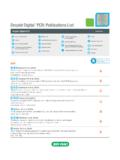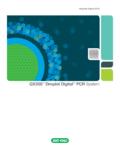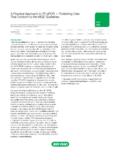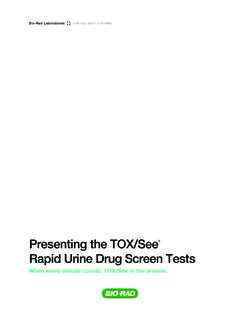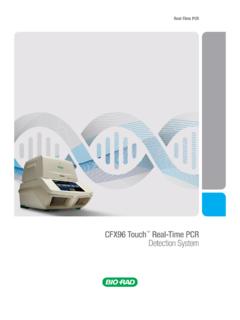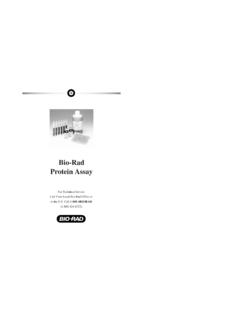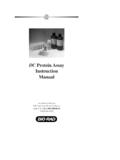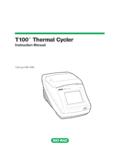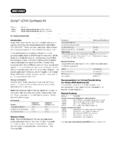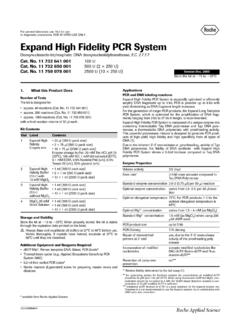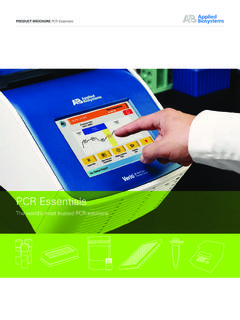Transcription of High-Fidelity PCR Kit iProof - Bio-Rad Laboratories
1 iProof High-Fidelity PCR Kit2 units/ l, 25 l50U172-53302 units/ l, 100 l200U172-5331 For research purposes onlyStore at -20 CiProof is a High-Fidelity DNA polymerase that offers extreme performance for all PCRapplications. Incorporating an exciting new and patented technology, iProof DNApolymerase brings together a novel Pyrococcus-like enzyme with a processivity enhancingdomain. This allows for the generation of long templates with an accuracy and speedpreviously unattainable with a single enzyme. The extreme fidelity of iProof makes it asuperior choice for cloning. The error rate of iProof polymerase is determined to be x 10-7in iProof HF buffer, which is approximately 50-fold lower than that of Thermus aquaticus,and 6-fold lower than that of Pyrococcus iProof high fidelity PCR Kit includes lambda DNA control template and primers kb and 10 kb positive control amplicons. Sufficient template is included for performing20 x 50 l or 50 x 20 l and StabilityStore the iProof High-Fidelity PCR Kit at -20 C in a constant temperature freezer.
2 Whenstored under these conditions, the polymerase is stable for one year after the ship ContentsReagent50U200 UDescriptioniProof Polymerase25 l100 liProof high fidelity DNAP olymerase, 2 units/ liProof HF ml3 x ml5X HF Buffer, mM MgCl2iProof GC ml3 x ml5X GC Buffer, mM MgCl2dNTP mix100 l100 ldNTP solution, 10 mM ml50 mM MgCl2solutionControl ltemplate40 l40 lControl ltemplate, ng/ kb primers50 l50 l4 M each10 kb primers50 l50 l4 M eachDNA Standard200 l400 lDNA size standardDMSO500 l500 l100% DMSO solutioniProof DNA polymerase is unlike other enzymes. Please read the QuickGuidetomodify your protocol for optimal (See Notes About Cycling Conditions for details) Use 98 C for denaturation. Anneal at Tm+3 C (>20nt oligo). Use 15 30 sec/kb for extension times. Do not exceed 1 min/kb. Use iProof at U per 50 l reaction. Do not exceed 2 U/50 l. Use 200 M dNTPs. Do not use dUTP. iProof produces blunt end DNA About Cycling Conditions1.
3 DenaturationTemplate denaturation should be performed at 98 C. Due to the high thermostability ofiProof, denaturation temperatures greater than 98 C can be used. A 30 s initialdenaturation time is recommended, but this can be extended to 3 min for difficult DNAtemplates. Subsequent denaturation should be performed for 5 10 s at 98 AnnealingWhen using iProof , a general rule is to anneal primers (>20 nt) for 10 30 s at +3 Cabove the primer with the lowest Tm. Primer Tmshould be calculated using the nearest-neighbor method as results can vary significantly depending on the method used. Forprimers <20 nt, use an annealing temperature equal to the primer with the lowest ExtensionTemplate extension should be performed at 72 C and extension time depends onamplicon length and complexity. For low complexity DNA ( plasmid, lambda, orBAC DNA) use 15 s per kb. For high complexity DNA ( genomic DNA) use 30 s perkb. Do not exceed 1 min per kb for amplicons that are >5 Amplification Products From Bio-Rad LaboratoriesReagents for PCR or Real-Time PCRiProof High-Fidelity DNA Polymerase172-5301iProof HF Master Mix172-5310iProof GC Master Mix172-5320iTaq DNA Polymerase170-8870iTaq Supermix With ROX170-8854iTaq SYBR Green Supermix With ROX170-8850iQ Supermix170-8860iQ SYBR Green Supermix170-8880iScript cDNA Synthesis Kit170-8890iScript Select cDNA Synthesis Kit170-8896iScript One-Step RT-PCR Kit with SYBR Green170-8892iScript One-Step RT-PCR Kit for Probes170-8894 For ordering information on larger pack sizes, or to learn more about Bio-Rad amplificationreagents and instruments, visit TO PURCHASER: LIMITED LICENSEUse of this product is covered by one or more of the following US patents and corresponding patent claims outsidethe US: 5,079,352, 5,789,224, 5,618,711, 6,127,155 and claims outside the US corresponding to US Patent ,889,818.
4 The purchase of this product includes a limited, non-transferable immunity from suit under the foregoingpatent claims for using only this amount of product for the purchaser s own internal research. No right under anyother patent claim (such as the patented 5 Nuclease Process claims in the US Patent Nos. 5,210,015 and5,487,972), no right to perform any patented method, and no right to perform commercial services of any kind,including without limitation reporting the results of purchaser s activities for a fee or other commercial consideration,is conveyed expressly, by implication, or by estoppel. This product is for research use only. Diagnostic uses underRoche patents require a separate license from Roche. Further information on purchasing licenses may be obtainedby contacting the Director of Licensing, Applied Biosystems, 850 Lincoln Centre Drive, Foster City, California 94404, , iTaq, iQ, and iScript are trademarks of Bio-Rad Rev BBio-Rad Laboratories2000 Alfred Nobel Drive, Hercules, CA 94547510-741-1000 Reaction SetupImportant Note Please Read Before StartingSpin all tubes before opening to improve recovery.
5 Reactions should be set up on ice. Pipet allcomponents in the order given below. Always add iProof DNA Polymerase last to the reaction asprimer degradation may occur in the absence of dNTPs. It is recommended that you prepare amaster mix for the appropriate number of samples to be Reaction SetupVolume forVolume forComponent50 l reaction20 l reactionFinal iProof HF Buffer*10 l4 l1 XdNTP mix1 l200 M eachPrimer 1**x lx MPrimer 2**x lx MDNA templatex lx lSterile H20x lx liProof DNA l** U/ lTotal Volume50 l20 l* For difficult or GC-rich templates, 5X iProof GC Buffer can be used.** Recommended final primer concentration is M; can range between M.** Enzyme should be diluted to avoid pipeting Template Reaction SetupVolume forVolume forComponent50 l reaction20 l reactionFinal iProof HF Buffer10 l4 l1 XdNTP mix1 l200 M eachPrimers * l1 MControl DNA Template2 lSterile H2034 liProof DNA l** U/ lTotal Volume50 l20 l* Either kb or 10 kb primers** Enzyme should be diluted to avoid pipetting About Reaction Components1.
6 iProof DNA PolymeraseThe optimal amount of enzyme depends on the amount of template and the length ofthe PCR product. Usually 1 unit of iProof DNA polymerase per 50 l reaction will givegood results, but optimal amounts could range from 2 units per 50 l reactiondepending on amplicon length and difficulty. Do not exceed 2 U/50 l ( U/ l),especially for amplicons that are > BuffersTwo buffers are provided: 5x iProof HF buffer and 5x iProof GC buffer. The error rate ofiProof polymerase in HF buffer ( x 10-7) is lower than that in GC buffer ( x 10-7).Therefore, the HF buffer should be used as the default buffer for high fidelity , the GC buffer can improve iProof performance on certain difficult or longtemplates, GC rich templates or those with complex secondary structures. Only useGC buffer when amplification with HF buffer does not provide satisfactory Mg2+and dNTPMg2+concentration is critical since iProof is a Mg2+-dependent enzyme. ExcessiveMg2+stabilizes dsDNA, preventing complete denaturation, and can also promoteinaccurate priming.
7 Conversely, insufficient amounts of Mg2+can lead to low productyield. The optimal Mg2+concentration also depends on dNTP concentration, thespecific DNA template and the sample buffer composition. The optimal Mg2+concentration is to 1 mM over the total dNTP concentration for standard PCR. Foroptimization, increase or decrease Mg2+concentration in mM high quality dNTPs should be used. Use of dUTP or other dUTP-derivatives oranalogs is not recommended. Due to the increased processivity of iProof , there is noadvantage to increasing dNTP amounts. For optimal results, use 200 mM DNA TemplateGeneral guidelines are 1 pg 10 ng of DNA template in a 50 l reaction for lowcomplexity DNA ( plasmid, lambda, or BAC DNA). For high complexity DNA ( DNA), 50 500 ng of template DNA should be used in a 50 l PCR AdditivesThe recommended reaction conditions for GC-rich templates include the addition of3% DMSO which aids in template denaturation. Further optimization of DMSO shouldbe made in 2% increments.
8 In some cases, DMSO may be used to help relaxsupercoiled plasmid DNA. high DMSO concentrations (10%) will require lowering theannealing temperature by C. Other PCR additives such as formamide,glycerol, and betaine are also compatible with ConditionsImportant Note Please ReadDue to the novel nature of iProof DNA polymerase, optimal reaction conditions may differ fromstandard PCR protocols. iProof works better at elevated denaturation and annealing temperaturesdue to higher salt concentration in the reaction Thermal Cycling ProtocolCycle of CyclesInitial Denaturation98 C30 s1 Denaturation98 C5 10 sAnnealing45 72 C10 30 s25 35 Extension72 C15 30 s / kbFinal Extension72 C5 10 min1 Control Template ( kb) Cycling Protocol (2-step)Cycle of CyclesInitial Denaturation98 C1 min1 Denaturation98 C5 sAnnealing/Extension72 C20 s25 35 Final Extension72 C10 min1 Control Template (10 kb) Cycling Protocol (3-step)*Cycle of CyclesInitial Denaturation98 C1 min1 Denaturation98 C5 sAnnealing60 C15 s25 35 Extension72 C2 min 30 secFinal Extension72 C10 min1* Both control template reactions can be run using the 10 kb cycling protocol.
